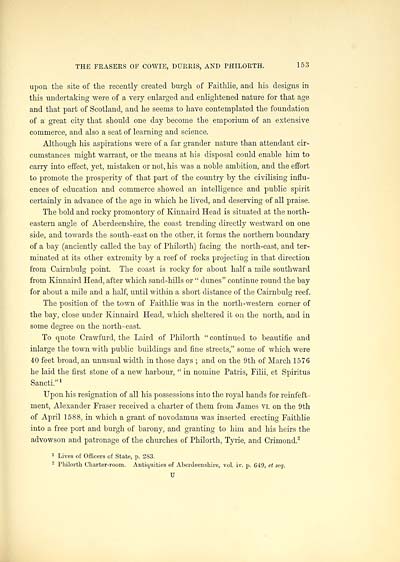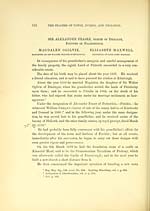Frasers of Philorth > Volume 1
(187)
Download files
Complete book:
Individual page:
Thumbnail gallery: Grid view | List view

THE FRASEKS OF COWIE, DURRIS, AND PHILORTH. 153
upon the site of the recently created burgh of Faithlie, and his designs in
this undertaking were of a very enlarged and enlightened nature for that age
and that part of Scotland, and he seems to have contemplated the foundation
of a' great city that should one day become the emporium of an extensive
commerce, and also a seat of learning and science.
Although his aspirations were of a far grander nature than attendant cir-
cumstances might warrant, or the means at his disposal could enable him to
carry into effect, yet, mistaken or not, his was a noble ambition, and the effort
to promote the prosperity of that part of the country by the civilising influ-
ences of education and commerce showed an intelligence and public spirit
certainly in advance of the age in which he lived, and deserving of all praise.
The bold and rocky promontory of Kinnaird Head is situated at the north-
eastern angle of Aberdeenshire, the coast trending directly westward on one
side, and towards the south-east on the other, it forms the northern boundary
of a bay (anciently called the bay of Philorth) facing the north-east, and ter-
minated at its other extremity by a reef of rocks projecting in that direction
from Cairnbulg point. The coast is rocky for about half a mile southward
from Kinnaird Head, after which sand-hills or " dunes" continue round the bay
for about a mile and a half, until within a short distance of the Cairnbulg reef.
The position of the town of Faithlie was in the north-western corner of
the bay, close under Kinnaird Head, which sheltered it on the north, and in
some degree on the north-east.
To quote Crawfurd, the Laird of Philorth " continued to beautifie and
inlarge the town with public buildings and fine streets," some of which were
40 feet broad, an unusual width in those days ; and on the 9th of March 1576
he laid the first stone of a new harbour, " in nomine Patris, Filii, et Spiritus
Sancti." 1
Upon his resignation of all his possessions into the royal hands for reinfeft-
ment, Alexander Fraser received a charter of them from James vi. on the 9th
of April 1588, in which a grant of novodamus was inserted erecting Faithlie
into a free port and burgh of barony, and granting to him and his heirs the
advowson and patronage of the churches of Philorth, Tyrie, and Crimond. 2
1 Lives of Officers of State, p. 283.
2 Philorth Charter-room. Antiquities of Aberdeenshire, vol. iv. p. 649, et seq.
U
upon the site of the recently created burgh of Faithlie, and his designs in
this undertaking were of a very enlarged and enlightened nature for that age
and that part of Scotland, and he seems to have contemplated the foundation
of a' great city that should one day become the emporium of an extensive
commerce, and also a seat of learning and science.
Although his aspirations were of a far grander nature than attendant cir-
cumstances might warrant, or the means at his disposal could enable him to
carry into effect, yet, mistaken or not, his was a noble ambition, and the effort
to promote the prosperity of that part of the country by the civilising influ-
ences of education and commerce showed an intelligence and public spirit
certainly in advance of the age in which he lived, and deserving of all praise.
The bold and rocky promontory of Kinnaird Head is situated at the north-
eastern angle of Aberdeenshire, the coast trending directly westward on one
side, and towards the south-east on the other, it forms the northern boundary
of a bay (anciently called the bay of Philorth) facing the north-east, and ter-
minated at its other extremity by a reef of rocks projecting in that direction
from Cairnbulg point. The coast is rocky for about half a mile southward
from Kinnaird Head, after which sand-hills or " dunes" continue round the bay
for about a mile and a half, until within a short distance of the Cairnbulg reef.
The position of the town of Faithlie was in the north-western corner of
the bay, close under Kinnaird Head, which sheltered it on the north, and in
some degree on the north-east.
To quote Crawfurd, the Laird of Philorth " continued to beautifie and
inlarge the town with public buildings and fine streets," some of which were
40 feet broad, an unusual width in those days ; and on the 9th of March 1576
he laid the first stone of a new harbour, " in nomine Patris, Filii, et Spiritus
Sancti." 1
Upon his resignation of all his possessions into the royal hands for reinfeft-
ment, Alexander Fraser received a charter of them from James vi. on the 9th
of April 1588, in which a grant of novodamus was inserted erecting Faithlie
into a free port and burgh of barony, and granting to him and his heirs the
advowson and patronage of the churches of Philorth, Tyrie, and Crimond. 2
1 Lives of Officers of State, p. 283.
2 Philorth Charter-room. Antiquities of Aberdeenshire, vol. iv. p. 649, et seq.
U
Set display mode to:
![]() Universal Viewer |
Universal Viewer | ![]() Mirador |
Large image | Transcription
Mirador |
Large image | Transcription
Images and transcriptions on this page, including medium image downloads, may be used under the Creative Commons Attribution 4.0 International Licence unless otherwise stated. ![]()
| Histories of Scottish families > Frasers of Philorth > Volume 1 > (187) |
|---|
| Permanent URL | https://digital.nls.uk/96567744 |
|---|
| Attribution and copyright: |
|
|---|
| Description | A selection of almost 400 printed items relating to the history of Scottish families, mostly dating from the 19th and early 20th centuries. Includes memoirs, genealogies and clan histories, with a few produced by emigrant families. The earliest family history goes back to AD 916. |
|---|

